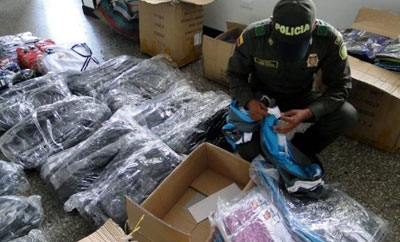In just the first 20 days of January 2014, Colombia’s tax and customs police (Polfa) seized nearly $6.5 million in contraband products. The most commonly smuggled items were clothes, shoes and food, raising questions about who is behind the bulk of this trade.
Textiles make up the bulk of seizures made in Colombia — over $30 million in textiles were seized in 2013, representing 46 percent of all goods. These are followed by food, shoes, perfume and motor vehicles, reported Portafolio.
The trade poses a major financial problem for domestic businesses, which are unable to compete with the extremely low prices of contraband goods.
General Jorge Hernando Nieto, director of citizen security for the national police, said his unit will be prioritizing the issue of contraband in the coming year. This, he said, will allow them to “simultaneously combat connected crimes, such as money laundering, drug trafficking, extortion, and the wealth of illegal groups.”
InSight Crime Analysis
The daily seizure average, if maintained throughout the year, would equal approximately $118 million in goods by the end of 2014. This is just a fraction of the annual market worth of the trade, estimated at around $6 billion. According to the Financial Analysis and Information Unit (UIAF), this represents 1.7 percent of Colombia’s annual gross domestic product (GDP).
Venezuela is a major source of this trade, with up to 40 percent of items imported into the country later smuggled into Colombia, according to the Venezuelan government. Venezuelan gasoline, and liquor and cigarettes from duty free zones in places like Colon, Panama are some of the most often cited products in Colombia’s contraband market. These are thought to be largely controlled by criminal groups like the Urabeños and the Rastrojos, who use the trade to launder drug money.
SEE ALSO: Coverage of Money Laundering
Given this, it is interesting such a high percentage of contraband seizures are attributed to clothing and shoes — not products usually associated with Colombia’s criminal groups. One Polfa official said the majority of these contraband products come from China, meaning the smuggling method would also be different.
If the seizures are representative of the overall market, it raises the question of who is controlling this lucrative clothing trade. It is also plausible, however, that these items are more commonly seized because the larger criminal groups controlling gasoline and alcohol have more sophisticated smuggling structures and networks of corruption facilitating their passage.

